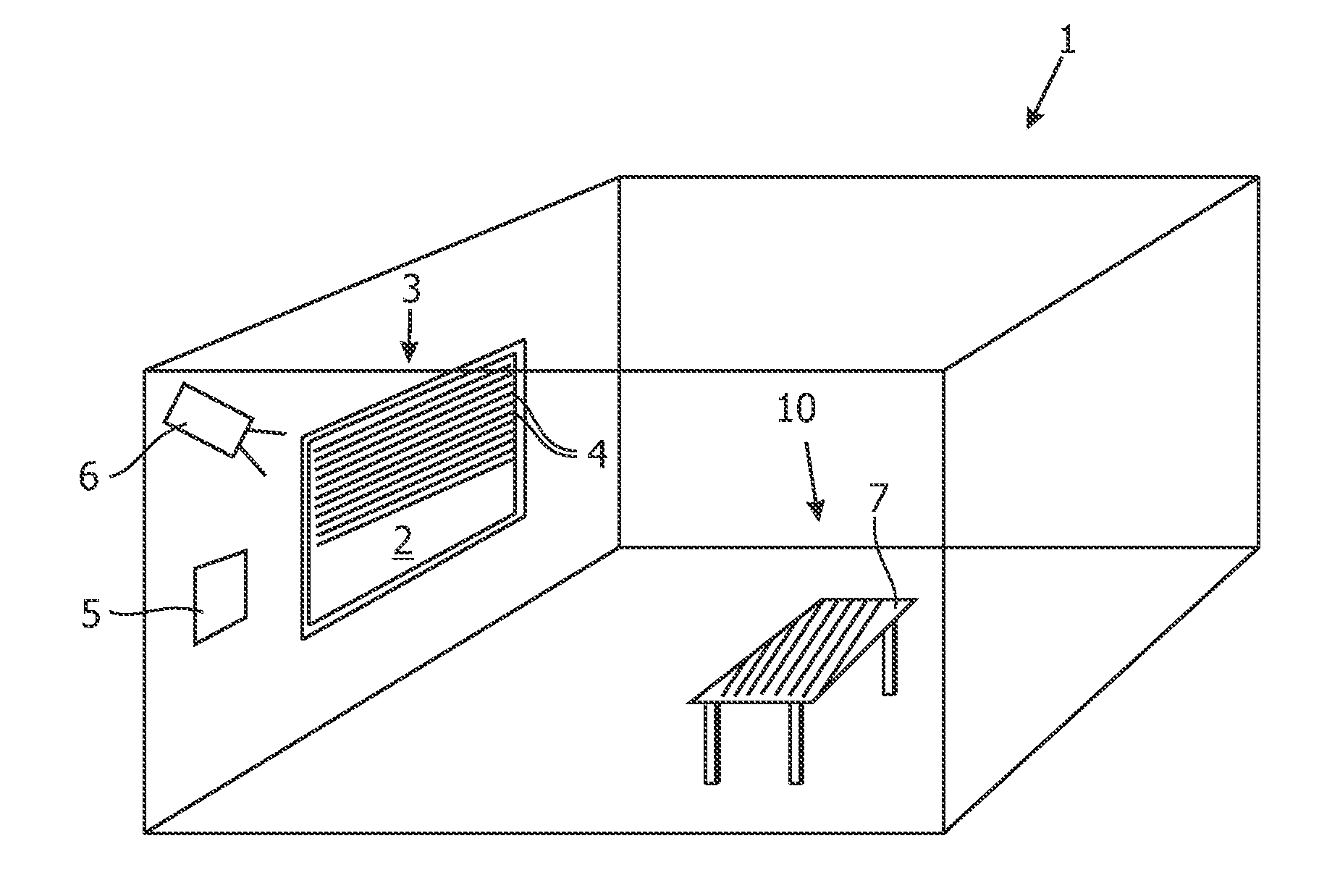System and method for controlling a shading device
- Summary
- Abstract
- Description
- Claims
- Application Information
AI Technical Summary
Benefits of technology
Problems solved by technology
Method used
Image
Examples
first embodiment
[0071]FIG. 1 shows a three-dimensional view of a system for controlling a shading device, installed in a room 1, e.g. a room of an office building. The room 1 comprises a window 2 to the outside of the office building.
[0072]The window 2 comprises a common venetian slat blind 3, having a plurality of separate rectangular slats 4, arranged horizontally. The angle of the slats 4, i.e. the tilt angle, is controllable using an electric motor and a corresponding suspension system (not shown). Furthermore, the height to which the slats are lowered is controllable.
[0073]The slat blind 3 is connected to a control unit 5 using a wireless connection for controlling the tilt angle of the slats 4.
[0074]A CCD camera 6 is arranged to observe the room 1 and especially a desk 7, shaded by the slat blind 3 from sunlight, falling through the window 2. The camera 6 is connected to the control unit 5 using a wireless connection.
[0075]A schematic block diagram of the system according to the present embod...
second embodiment
[0083]Additionally or alternatively to the arrangement of the camera 6, observing the room 1, sensor modules 31 may be provided on the window frame 32 of the window 2, as shown in the inventive system in FIG. 3.
[0084]The embodiment of FIG. 3 corresponds to the embodiment of FIGS. 1 and 2, with the exception that instead of a camera 6, two sensor modules 31 are arranged on the window frame 32 of the window 2 to detect the stripe pattern 10, allowing a very compact setup of the system.
[0085]The sensor modules 31 comprise e.g. linear sensor arrays of the type MRX90255BC, available from Melexis Corp. The details of the operation of the embodiment of FIG. 3 correspond to the embodiment of FIGS. 1 and 2.
third embodiment
[0086]the inventive system for controlling a shading device is shown in FIG. 4 in a three-dimensional view of the room 1. The present embodiment corresponds substantially to the embodiment of FIG. 1, but instead of a camera 6, a photodiode 41 is arranged in the room 1, connected to the control unit 5. The operation of the system, shown in FIG. 4 is hereinafter explained with the reference to the flow diagram of FIG. 5.
[0087]According to the present embodiment, a detection of glare resulting from direct light, transmitted through the shading device, is based on the detection of a change of the gradient of the luminance in the room 1 when varying the tilt angle of the slats 4.
[0088]In present embodiment, the control unit 5 is configured for conducting a calibration procedure, which is initiated in step 51 by the control unit 5 in response to a control command of the central control system 8 or of the manual controller 9. Alternatively, the procedure may be conducted on a periodic basi...
PUM
 Login to View More
Login to View More Abstract
Description
Claims
Application Information
 Login to View More
Login to View More - R&D
- Intellectual Property
- Life Sciences
- Materials
- Tech Scout
- Unparalleled Data Quality
- Higher Quality Content
- 60% Fewer Hallucinations
Browse by: Latest US Patents, China's latest patents, Technical Efficacy Thesaurus, Application Domain, Technology Topic, Popular Technical Reports.
© 2025 PatSnap. All rights reserved.Legal|Privacy policy|Modern Slavery Act Transparency Statement|Sitemap|About US| Contact US: help@patsnap.com



